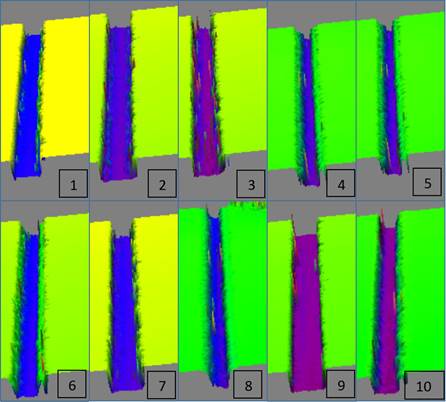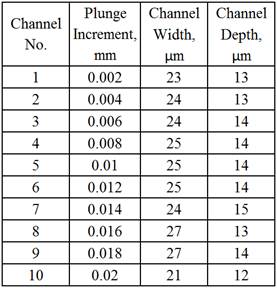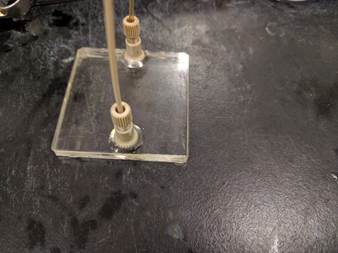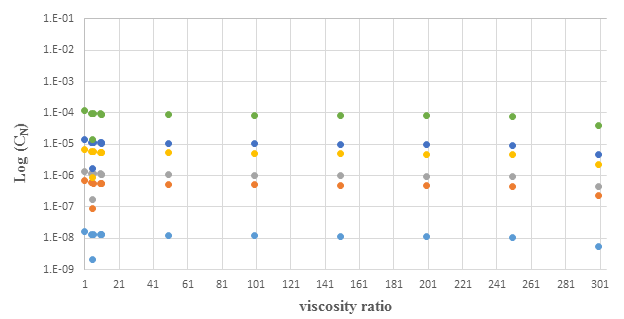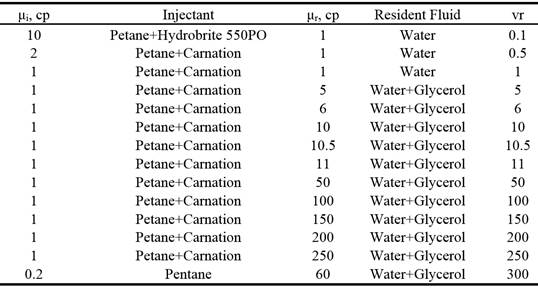Reports: DNI955795-DNI9: An Experimental Investigation of Flow Instabilities and Time-Dependence of the Constitutive Relationships of Multiphase Flow in Porous Media
Saman A. Aryana, PhD, University of Wyoming
Current challenges to understanding multiphase dynamics in flow through porous media arise from difficulties in characterizing the heterogeneity and complexity inherent in natural geological porous media and the instability of flow dynamics due to contrasts in density and viscosity between the invading and the resident fluids. The objective of this study is to examine and characterize flow instabilities and the need for a non-compact spatial and/or temporal support for the constitutive relations for macroscale models of multiphase flow in porous media. To that end, we have designed and fabricated microfluidic devices using a two-dimensional representation of a sample of Berea sandstone.
The experimental setup comprises two major components: 1) devices that are capable of withstanding high enough pressures to be able to investigate flow dynamics concerning supercritical CO2 and brine or oil, and 2) capturing images of the entire medium (approximately 5cm X 5cm) with high enough resolution to be able to discern microscale features in the entire domain.
The first choice of material to build the microfluidic devices was sapphire. This was mainly due to its superior mechanical properties compared to typical material used in such devices, including glass, silicon, Polydimethylsiloxane (PDMS) and polymethyl-methacrylate (PMMA). Sapphire has a remarkable hardness (third highest after diamond and moissanite) and does not deform appreciably under pressure (unlike PMMA and PDMS [1]). In a collaborative effort (J. Squier, Colorado School of Mines; J. Oakey and C. Frick, University of Wyoming), microscale channels were etched on sapphire substrates using femto-second laser pulses [2]. The resulting channels were characterized as a function of etching parameters, including power settings, translational speed of the platform and the number and increment of plunges. Due to the crystalline structure of sapphire, channel geometries are not always consistent and they appear to be very sensitive to the positioning of the source of laser. Also, creating a complex network of channels that resembles a sample of rock would be a burdensome proposition. The etching process is similar to milling and would require extensive programming of the etching equipment and the potential inconsistency in the resulting channels would be obstacles to producing a working microfluidic device to study flow in representations of rock samples.
Figure 1: Channels etched on sapphire via femto-second laser pulses – four lateral plunges with a lateral movement of 0.003 mm, power set at 10 mW and cutting speed of 1 mm/s
Table 1: Channel dimensions
The next challenge in using sapphire substrates is bonding. There were attempts to bond two sapphire substrates using various chemicals. The strongest bond was achieved using a sodium silicate solution [3]. The bonding chemical appeared to infiltrate into the channels and block flow in every sample. A thermal bonding process was also considered, which would require raising the temperature of the substrates to near its melting point. Due to the relatively high melting point of sapphire (slightly over 2,000 C), thermal bonding was not attempted. Finally, we were able to achieve a successful bond by focusing femto-second laser pulses at the interface between the two substrates. The compressive shear of the bond was tested on single lap joined circular disks, which creates similar failure modes to ASTM D5401 and other literatures of shear strength measurement of ceramic joints [4].
In conclusion, due to inconsistent channel geometries in sapphire, the restrictions regarding etching complex networks with varying channel geometries and bonding related concerns, I am of the opinion that sapphire is not a good choice for fabrication of microfluidic devices to study flow processes in complex networks related to earth sciences. The results of this effort will be disseminated in a paper (currently in preparation).
Figure 2: a) the fixture with sample loaded, b) dismantled fixture. The curved surfaces of the sample holders have same curvature to the samples round surface (courtesy of Prof. C. Frick, University of Wyoming).
Figure 3: a) Shear force vs. displacement plot at the displacement rate of 0.01mm/s. b) The failed sample shows that the bonded disks split at the interface without any damage to the disks (courtesy of Prof. C. Frick, University of Wyoming).
In the next phase, we focused our efforts on building devices using borofloat. The two-dimensional representation of the rock sample was etched onto the substrate using a wet etching process. The etched substrate was then bonded thermally to a blank substrate. Initially, the resulting device would not withstand pressures higher than approximately 500 psi. With extensive experimentation and testing, the bonding protocol was refined and the latest device was successfully tested up to 1,300 psi.
Figure 4: Microfluidic device
The data collection system uses an achromatic 60 MP sensor and a cooled transilluminator. The light output has been modified to detect features of interest. The system was tested to explore flow dynamics of foam in the microfluidic device.
Figure 5: Distribution of foam in a microfluidic device
We are currently conducting flow experiments using various fluid mixtures with a focus on flow instabilities. The experiments cover a wide range of viscosity ratios and capillary numbers (hence various flow regimes).
Figure 6: Viscosity ratios (M) and capillary numbers (Nca) of a sample of planned flow experiments.
Table 2: Sample of planned flow experiments
References:
1. H. Bourbaba, C. Ben achaiba and B. Mohamed, Mechanical Behavior of Polymeric Membrane: Comparison between PDMS and PMMA for Micro Fluidic Application, Energy Procedia, Vol. 36, (2013), 231- 237.
2. X. Wang, G. Lim, W. Liu, S. Chua, H. Zheng, and F. Ng, Femtosecond Pulse Laser Ablation of Sapphire in Ambient Air, Appl. Surf. Sci., Vol. 228, No. 1 (2004), 221-226.
3. R. Douglas, A.A. van Veggel, L. Cunningham, K. Haughian, J. Hough, and S. Rowan, Cryogenic and room temperature strength of sapphire jointed by hydroxide-catalysis bonding, Classical and Quantum Gravity, Vol 31, No. 4 (2014).
4. A. Dari, F. Travasso, H. Vocca, and L. Gammaitoni, Breaking strength tests on silicon and sapphire bondings for gravitational wave detectors, Classical and Quantum Gravity, Vol. 27, No. 4 (2010).

